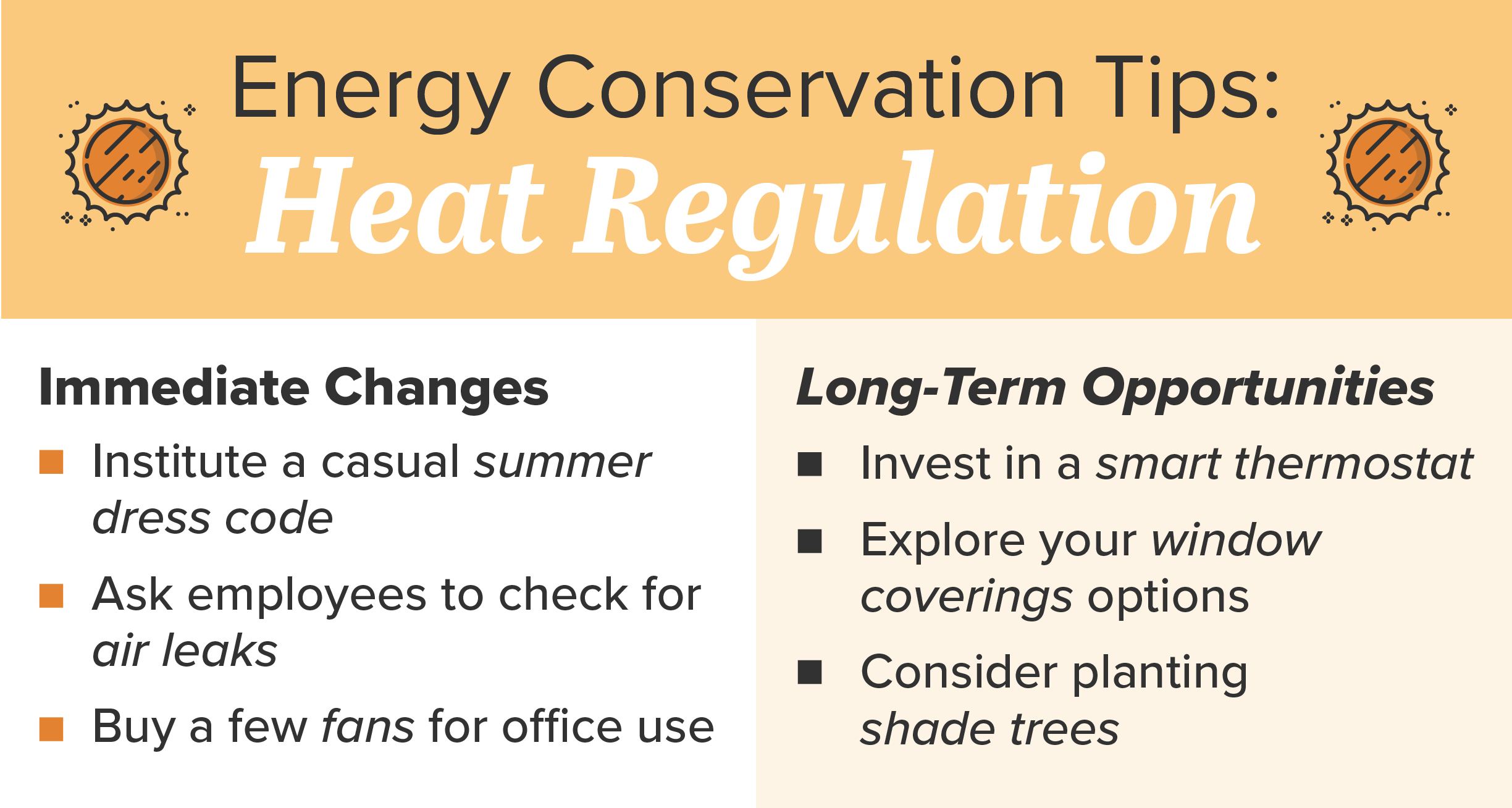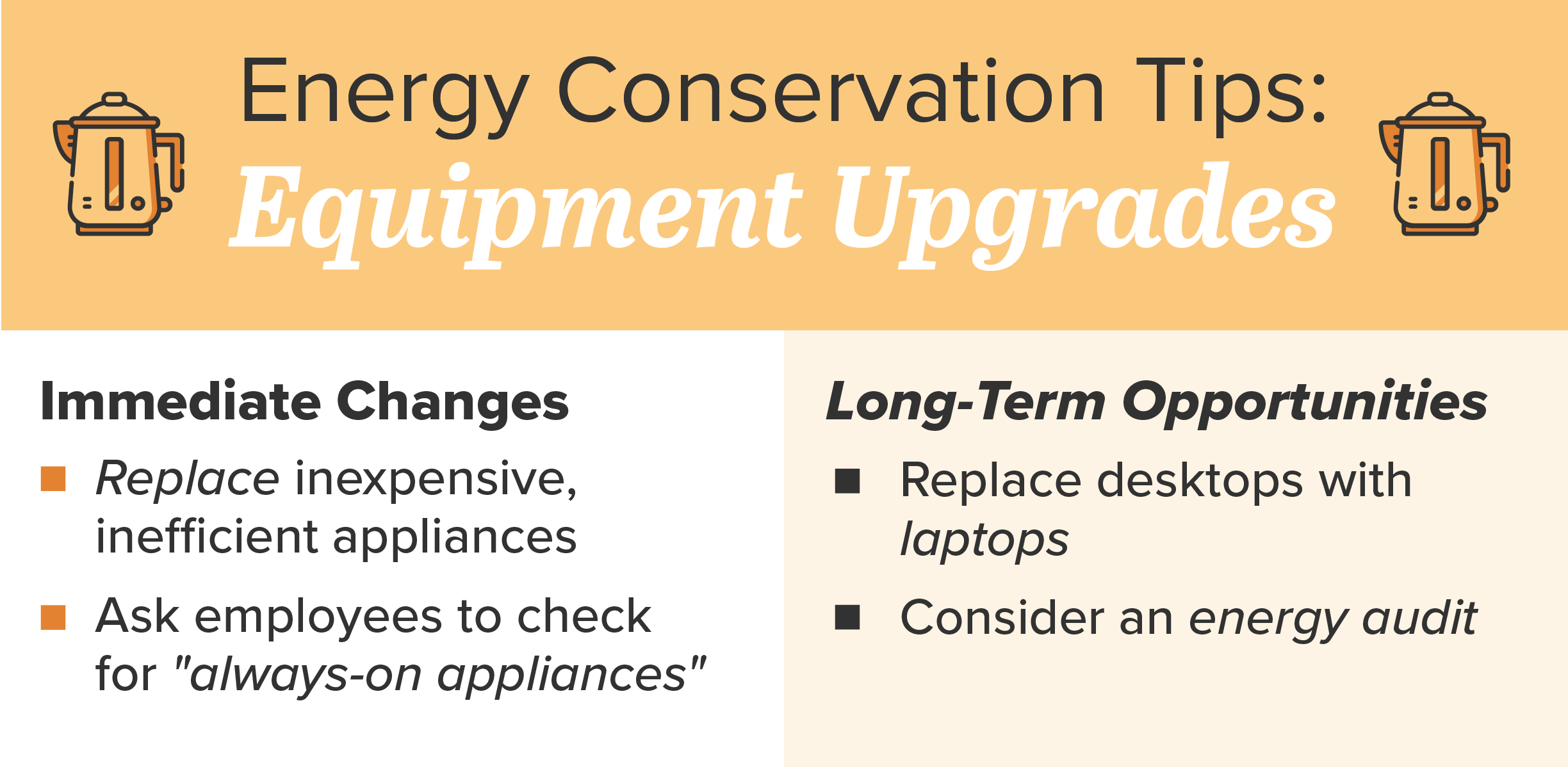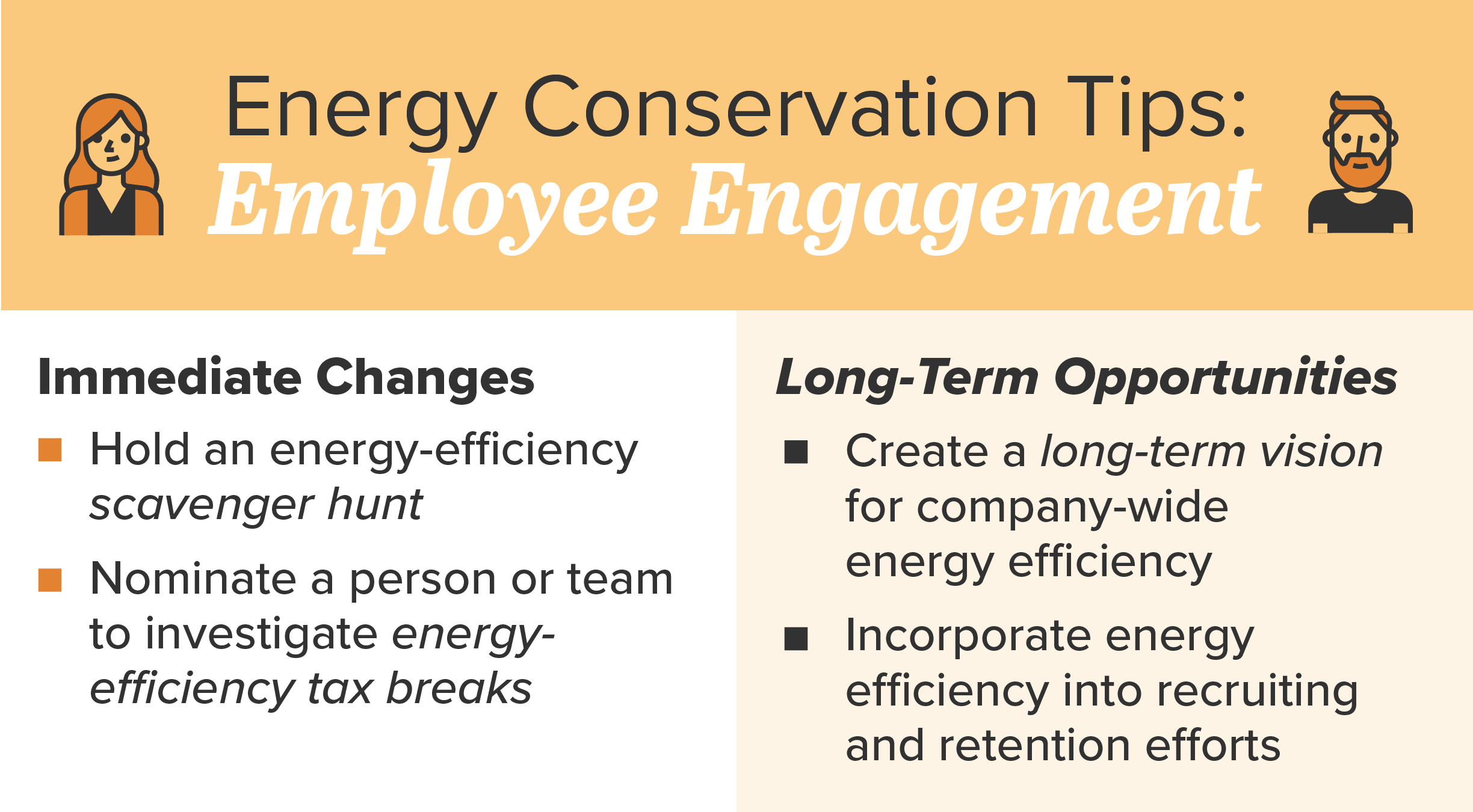Energy conservation isn't a choice to consider – it's a competitive advantage you can't afford to ignore
"The slightest persistent waste can brutalize a small business where risk tolerance is low and margins are tight," said Tom Paladino, founder and CEO of Paladino and Company, an award-winning, green building consulting firm. "These businesses must eliminate any waste that they can to protect the bottom line."
This guide offers actionable advice surrounding the four main opportunities for energy savings:
- Lighting
- Heat regulation
- Equipment upgrades
- Employee engagement
Let's get started on saving you money.
Lighting
You know that LED lights (light-emitting diodes) are more efficient than traditional lightbulbs, but do you realize just how much more? According to the U.S. Department of Energy, LED lights use& 80% less energy and can last 25 times longer.
Lighting in large spaces
The areas where your employees sit needs light throughout the workday. The large fluorescent lightbulb tubes that illuminate many workspaces are more energy-efficient than incandescent light, but newer technology has made them even more efficient.
Fluorescent light ballasts, which regulate the current to the lamps, have also improved. New electromagnetic ballasts operate at cooler temperatures, which saves energy. They also result in less flickering flight and noise from the bulbs.
Lighting in conference rooms, bathrooms and break rooms
Rooms that are occupied sporadically don't need permanent light. Consider installing occupancy sensors. These devices regulate light depending on whether or not someone is in the room. For example, an occupancy sensor can be set so that lights automatically turn on when anyone enters the room.
Occupancy sensors have an extra safety benefit, since no one will be walking into a dark room. Vacancy sensorsare a similar option. These devices don't turn on the light automatically when a person enters a room, but they do turn the lights off when a person leaves the room. This way, a business owner who feels the natural light in the room is sufficient avoids unnecessary, energy-consuming artificial light. When someone turns on a light, it turns off after they leave.
Lighting fixtures are another opportunity for cash savings. Old lighting fixtures trapped light for aesthetic reasons. Newer fixtures push light out into rooms thanks to brighter reflectors and better geometry.
Outdoor lighting
Better lighting in outdoor areas around your business is safer and can entice more customers. When lighting outdoor spaces, you can benefit from the ultimate cost-saver: solar lighting. Solar lights are simple to install and should work with minimal upkeep. Keep two things in mind, though:
- Ensure the outdoor area gets enough daily sunlight to support your needs.
- Check the sensors periodically for cleanliness - accumulated dirt and grime can block the panels from getting the solar energy they need.
Natural light
You wouldn't turn down free money, and electric light costs money. So why would you turn down free light from the sun
Modern buildings with larger windows let in more light, and smart business owners take advantage of natural light in their workspaces. Since you can't know every employee's lighting preference or inspect every nook and cranny of the office (and the sun isn't always in the same place), involve your employees. Ask them for their ideas for using natural, free light instead of turning to artificial light, which saps your bottom line.
Heat regulation
You and your employees do your best work at a comfortable temperature, and maintaining that temperature comes at a cost. New technology and simple common sense can lower it. In a perfect world, your building would have all of the innovative technology in today's greenest buildings. If you can't convince your landlord to put in a vertical garden wall, consider these next tips.
Smart thermostats
The latest wireless technology makes it easier to maintain a constant temperature in your workspaces. You no longer have to rely on the last person who leaves the office at night to turn down the heat or shut off the AC.
"The smart thermostat can also 'learn' our temperature preferences and the hours of their use so that we get our space to our liking, but only when we need to," said Doug Keller, a community manager at Payless Power, an energy price comparison site.
Smart thermostats are like an employee you're paying to minimize heating costs, but more basic tech can help lower your costs as well.
Fans
A simple fan doesn't need much energy to push cooler air toward employees who need it. Fans make us feel cooler, even if the actual temperature doesn't change. Rather than paying for expensive air conditioning, see if you can get by with this low-tech option, and encourage employees to speak up if they'd like a fan.
Window coverings
The simple step of installing blinds, awnings, shades and other window coverings can keep employees comfortable. Blinds absorb the heat so your employees don't. According to the Department of Energy, blinds can reduce heat gain by as much as 80%.
You'll maximize your investment in window coverings if you talk to a professional who can help you understand the best options for window treatments based on the orientation of your building and the local climate. In colder climates, blinds can help retain heat, or they can be lowered so the sunlight helps heat parts of your office space.
Trees
Blinds and awnings block sunlight that shines into your building, but strategically placed trees can provide welcome shade. Trees will beautify your space and keep your heating bill down. Different trees do better in different areas. Consult a local landscape expert to get the best bang for your buck.
Casual dress
In Hawaii, aloha shirts are standard business attire. Residents of the 50th state made the sensible decision to eschew shirts, ties, and jackets that caused discomfort and inhibited productivity.
You can allow your employees to make the same choice and reap the benefits of a lower electricity bill. For every degree you raise your thermostat, you increase your energy savings by 2% to 3%.
Old weatherstripping and sources of other leaks
Another way to involve your employees is to ask them to check for defective weatherstripping around windows and doors or sources of other leaks around their desks. They may find gaps in your insulation that are costing you hundreds of dollars.
Equipment upgrades
The equipment you run is probably responsible for your biggest energy costs. The Department of Energy, though, makes it easy to find the most efficient options with its Energy Star program.
In specialized industries, an energy audit can uncover opportunities to save even more with newer equipment. Here are some of the most common equipment efficiencies you can address.
Appliances
"It's amazing the number of businesses I've seen that still use old appliances that waste huge amounts of energy," said Ian Wright, founder of British Business Energy. "In the last 10 years, there's been a real revolution in energy efficiency, so if you're using appliances that are older than 10 years, you're almost certainly wasting energy."
We're talking here about all the devices that use electricity – the coffee maker, the washing machine, the refrigerator. Your competitors may be using more energy-efficient versions and seeing more profits as a result.
Laptops vs. desktops
For energy efficiency, laptops are almost always a better choice than desktops. Laptops are designed for maximum power efficiency; they run on battery power, but they also tend to have fewer high-end components like video cards that suck power. One electricity expert estimates that you could spend.
If you're replacing desktop computers, consider whether your employees could do just as well with less energy-intensive laptops. Look for laptops that have an Energy Star rating, which is the government designation that tells you a product is a leader in energy efficiency.
Battery chargers, screens and other always-on devices
Did you know that battery chargers draw power even when they aren't charging a device? Just one battery charger isn't costing you much money, but every employee with a charger plugged in for the occasional smartphone top-up? That adds up fast.
So does the cost of operating screens in screensaver mode (which doesn't actually save any energy). Again, involve your employees. Ask them to identify where the slow drips of electricity waste in your company are occurring.
Employee engagement
Many energy-saving efforts will please your employees. What's not to like about a new coffee maker or lighter clothes on hot days? Employees will like these measures even more when you communicate that they save money, which makes the company – and their jobs – more stable.
We've already suggested a few opportunities for engaging your employees in your energy conservation efforts. Instead of making one-time changes, consider a longer-term solution that engages employees. Josh Prigge, a sustainability consultant, advises business owners to establish a cross-functional "green team" of employees who meet monthly to devise new ways of saving energy. Green teams can improve retention, job satisfaction, and overall company communication by bringing people together from different departments.
Another option is to designate a single employee as the company's energy efficiency officer. Empower this person to monitor energy costs and suggest solutions. One important effort this person could spearhead right away is investigating tax incentives for energy efficiency efforts. The Business Energy Investment Tax Credit is a federal tax break available for any U.S. business that qualifies. Many states, counties and cities offer their own programs. Your utility company may offer incentives as well.
Energy conservation during the coronavirus
The coronavirus (COVID-19) pandemic changed the way many employers operate their businesses. In the blink of an eye, many were forced to switch to a remote work environment. While some employers will incorporate remote work into their business model for the long term, others only see it as a temporary solution. Among those who intend to bring employees back to the office (or already have), some will bring their staff back full time, whereas others will implement a more flexible work schedule.
Each of these possibilities bring unique opportunities for businesses to conserve energy.
Remote teams
Employers who choose to keep a fully remote staff will likely want to let their office space go eventually. This is the ultimate energy-saving sacrifice. However, if you need to keep your company space for business purposes but don't plan on workers ever really being there, you will definitely want to take advantage of energy conservation tactics like smart thermostats and window coverings to keep the space dark and cool.
Unplug all unused devices and appliances to be sure they are not draining unnecessary energy. It's also important to conduct regular building evaluations to ensure there is no defective weatherstripping around windows or doors.
Partially remote teams
Employers who implement a flexible working schedule by allowing employees to split their time between working at the office and working from home can conserve energy by opting for a smaller office space. If only a few employees are in the office at a time, a large office space is probably unnecessary. A smaller office space will help you not only conserve energy, but also save money on leasing costs.
Employers with reduced workforces in the office can also implement a few energy conservation tools, like occupancy and vacancy sensors, to ensure lights don't stay on in any unused spaces.
If the dynamic of your team's work schedules has changed over the past year because of the coronavirus, it is time to assess your business's current and future energy needs.
Sustainability as a competitive advantage
For Paladino, his company's commitment to energy conservation is more than just a way to save money.
"We compete with industry giants for customers and talent," he said, "and when people experience our LEED Gold-certified office with its standing desks, organic fruit, operable windows, abundant plants, and engaged talent, it makes a difference."
We've given you ideas to start saving energy today. The real benefit will come from making these practices a permanent, integral part of your business.
"The most important thing for small businesses to understand is that going green in business is not a strategy to tack on to their business model," Paladino said. "Going green should be integrated into your operating philosophy. Whether you do it for the planet, or do it for the profit, or do it for the people, sustainability programs can improve your top and bottom line with a modest budget or no added cost at all."
Skye Schooley contributed to the writing and reporting in this article. Source interviews were conducted for a previous version of this article.




